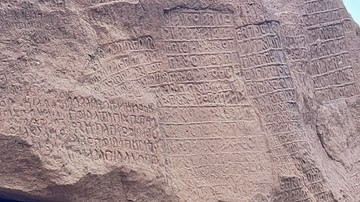Search Images
Browse Content (p. 4)

Image
Inscriptions at Jabal Ikmah
Jabal Ikmah, often referred to as an ‘open-air library’, contains hundreds of inscriptions engraved and carved in relief on the rock faces and boulders of a gorge, not far from Dadan, the seat of the Dadanite and Lihhyanite kingdoms, Saudi...

Image
Inscriptions and Petroglyphs at Jabal Ikmah
Jabal Ikmah, often referred to as an ‘open-air library’, contains hundreds of inscriptions and pictograms engraved and carved in relief on the rock faces and boulders of a gorge, not far from Dadan, the seat of the Dadanite and Lihhyanite...

Image
Jabal Ikmah
Jabal Ikmah, often referred to as an 'open-air library', contains hundreds of inscriptions engraved and carved in relief on the rock faces and boulders of a gorge, not far from Dadan, the seat of the Dadanite and Lihhyanite kingdoms, in Saudi...

Image
Interior of a Nabatean Tomb at Hegra
The interior of a tomb at Hegra, a UNESCO World Heritage Site at modern AlUla, Saudi Arabia, ancient Kingdom of Nabatea, 1st century BCE to the early 2nd century CE.

Image
Hegra, AlUla, Saudi Arabia
The spectacular landscape of Hegra, a UNESCO World Heritage site at AlUla, Saudi Arabia.

Image
Nabatean Tomb at Hegra
Nabatean tomb at the archaeological site of Hegra, one of many found at AlUla in Saudi Arabia. A UNESCO World Heritage Site, Hegra was a key city of the Kingdom of Nabatea, whose capital was based at Petra in Jordan. The Nabateans were based...

Image
Friedrich Paulus
A 1943 photograph of field marshal Friedrich Paulus (1890-1957) who led the defeated German Sixth Army during the battle of Stalingrad (July 1942 - February 1943) in the Second World War (1939-45). (National Museum of Denmark)

Image
Vasily Chuikov
A 1950 photograph of Marshal Vasily Chuikov (1900-82), best known for leading the successful Soviet defence of Stalingrad during the Battle of Stalingrad (July 1942 - February 1943) in the Second World War (1939-45).

Image
Soviet Troops, Stalingrad
A photograph of Soviet Red Army troops moving forward during the battle of Stalingrad (July 1942 - February 1943) during the Second World War (1939-45). (Imperial War Museums)

Image
Sojourner Truth
Abolitionist and Civil Rights Activist Sojourner Truth, photograph by Randall Studio, 1864, printed c. 1870.
National Portrait Gallery, Smithsonian Institution, Washington, D.C.